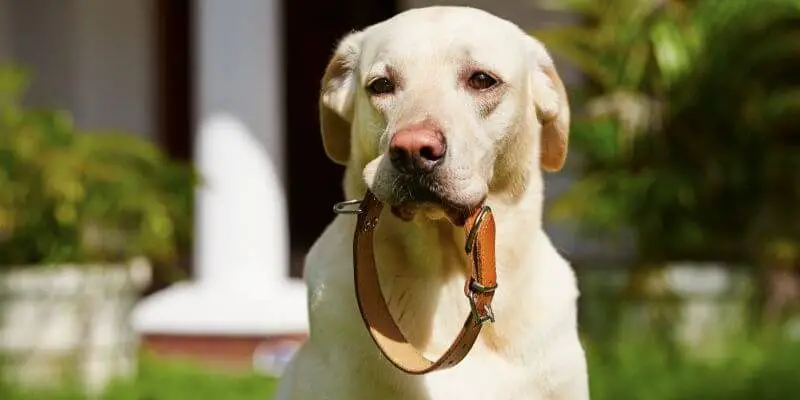
Can collars harm your dog?
- Written by Joshua Gordon
- Last updated

In this article
Can collars harm your dog?
Every responsible dog owner wants to do everything they can to make sure their pup is healthy and happy. But sometimes, in our attempt to keep them safe, we might be inadvertently doing more harm than good. Such is the case with dog collars.
While a collar is a necessary piece of equipment for any dog that goes outside, it’s important to be aware of the potential risks they pose to your pet.
Collars that are too tight can cause constriction and damage to the delicate tissues in your dog’s neck. This can lead to serious medical problems like respiratory difficulties, as well as less immediately apparent issues like long-term nerve damage.
On the other hand, collars that are too loose run the risk of getting caught on something, which could lead to your dog getting stuck or even hanged.
The best way to avoid these risks is to choose a collar that is the right size and fit for your dog, and to check it regularly to make sure it hasn’t become too tight or loose. With a little bit of care, you can keep your furry friend safe and healthy for years to come.
So, here is a list of the pros and cons of using a dog collar:
Pros:
- A dog collar is a necessary piece of equipment for any dog that goes outside.
- Collars can help you keep track of your dog if they ever get lost.
- Wearing a collar can help to socialize your dog and make them more comfortable around people.
Cons:
- Collars that are too tight can cause constriction and damage to the delicate tissues in your dog’s neck.
- Collars that are too loose run the risk of getting caught on something, which could lead to your dog getting stuck or even hanged.
- Some dogs may try to remove their collar, which could lead to them getting injured.
How to Find the Best Collar for Your Dog
Let’s now take a look at how you can find the best collar for your dog.
There are lots of different types of dog collars on the market, so it’s important to choose one that is right for your pet.
The most important factor to consider is the size of your dog’s neck, as this will determine the circumference of the collar. You should also take into account the thickness of your dog’s fur, as this will affect how tight the collar needs to be in order to stay secure.
Once you’ve taken these factors into account, you can start to narrow down your options by considering other features such as material, color, and design. If you’re not sure where to start, here are a few of the most popular types of dog collars:
- Buckle Collars: These collars fasten with a buckle, similar to a belt. They are adjustable, so you can make them tighter or looser as needed.
- Slip Collars: Also known as choke chains or check chains, these collars tighten when pulled, making them useful for training purposes. However, they can be dangerous if not used correctly, so it’s important to seek professional advice before using one.
- Martingale Collars: These collars work in a similar way to slip collars, but they have an extra loop that prevents them from tightening too much. This makes them safer to use, and they are often recommended for dogs with narrow heads.
- GPS Collars: These collars come equipped with a GPS tracker, so you can keep tabs on your dog’s location at all times. They are more expensive than other types of collar, but they offer peace of mind if you live in an area with a high risk of dog theft.
Now that you know the different types of dog collars available, it’s time to choose one that is right for your pet.
Here are a few tips to help you make the best decision:
- Read reviews: If you’re not sure which collar to choose, reading online reviews can be helpful. Just make sure you read them from a reputable source, such as a trusted pet website or blog.
- Ask your vet: Your veterinarian will be able to give you expert advice on which type of collar is best for your dog. They may also be able to recommend a specific brand or model.
- Talk to other dog owners: If you know someone else with a dog, ask them which type of collar they use. They may be able to offer helpful insights that you hadn’t considered.
Once you’ve chosen the perfect collar for your dog, it’s important to use it correctly. Here are a few tips:
- Make sure the collar is the right size: A too-tight collar can cause constriction and damage to your dog’s neck, while a too-loose collar could come off or get caught on something.
- Check the fit regularly: It’s important to check that the collar is still fitting properly, especially if your dog has gained or lost weight.
- Introduce the collar gradually: If your dog isn’t used to wearing a collar, introduce it gradually. Start by letting them wear it for short periods of time, and then increase the length of time as they get more comfortable.

Written by: Joshua Gordon
Head of Research and Editorial, Joshua has over 7 years of experience as a finance and automotive research consultant. He is a childhood pet owner and dog enthusiast.






